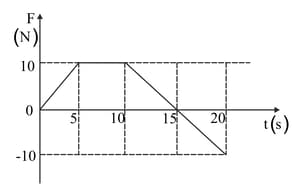EASY
Earn 100
It is dangerous to move out of moving bus. Why?
Important Questions on Force and Laws Of Motion
EASY
EASY
EASY

Which one of the following statements is correct for the interval from ?
EASY
Find the retardation with which a train moving at is brought to rest in seconds.
EASY
EASY
Define Newton's first law and Inertia.
MEDIUM
EASY
HARD
EASY
MEDIUM
When an object falls freely to the ground, its acceleration is uniform.
EASY
EASY
EASY
MEDIUM
Give scientific reasons.
Even though the magnitude of action force and reaction force are equal and their directions are opposite, their effects do not get cancelled.
MEDIUM
A body moves with constant velocity of . The mass of body is . The unbalanced force acting on the body is _____ .
EASY

